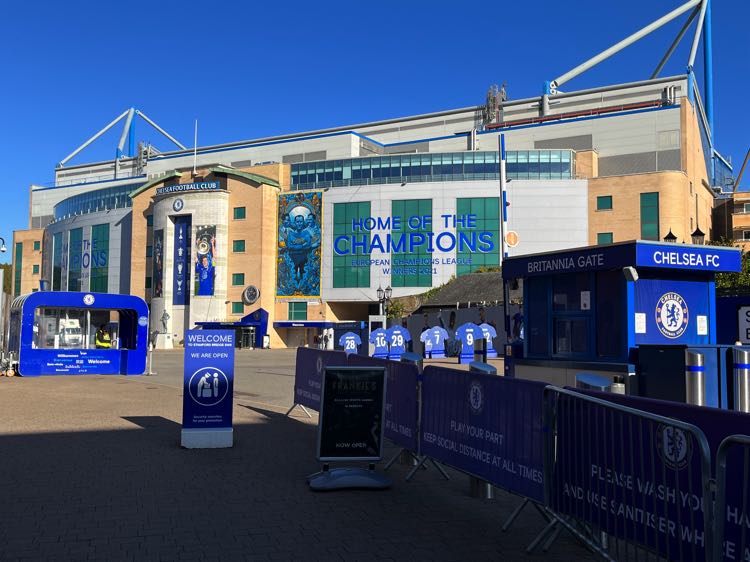Stamford Bridge has been home to Chelsea Football Club since 1905, the year in which the club was formed. The 41,837-capacity stadium is located in Fulham, and has undergone a number of major changes throughout Chelsea’s history, although it has never been demolished. Here we take a look at the history of the stadium and its construction and what the future may hold for the club and the ground.
Stamford Bridge Statistics
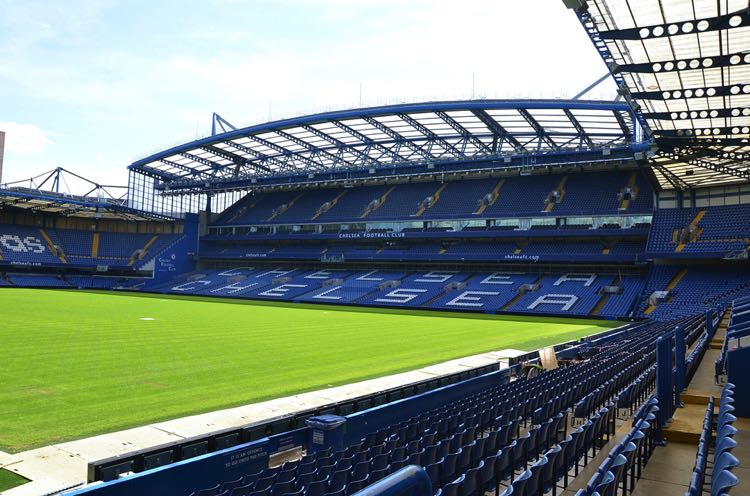
- Built: 1876
- Current Capacity: 41,837
- Record Attendance: 82,905
- Biggest Home Victory (League): 9-2 vs Glossop North End, 1906
- Biggest Home Victory (Europe): 13-0 vs Jeunesse Hautcharage, 1971
- Pitch Size: 103m x 67.7m
Stamford Bridge History
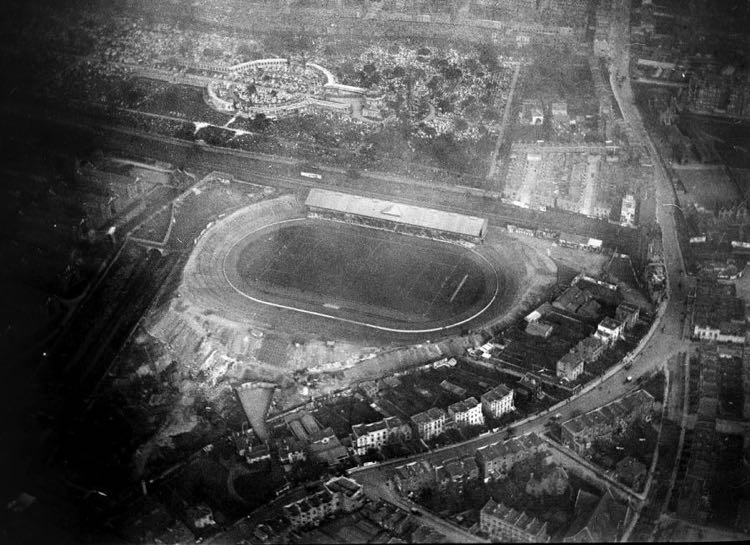
Chelsea have been around for well over 100 years so there is a lot of history to go at. Stamford Bridge has been their only permanent home, so let’s take a look back on when it was built, how it was funded and the other uses it has served besides being home to the Pensioners.
When Was the Ground Built?
Although Stamford Bridge has been the home of Chelsea for over a century, this has not always been the case. The ground itself was first built in 1876 and opened in 1877, some 30 years before the Blues were founded. The name “Stamford Bridge” stems from Counter’s Creek, a stream that ran past where the ground’s East Stand is now located.
This stream had two bridges, one of which was known as Stamford Bridge, and the rest, as they say, is history. When the original stadium opened in 1877, it was home to London Athletic Club, and therefore spent its early years as a ground for track and field sports, rather than football.
When Did Chelsea First Acquire the Ground?
In 1904, a pair of businessmen brothers, Gus and Joseph Mears, acquired Stamford Bridge’s lease, with the intention of turning the athletics stadium into a football ground where high-profile matches would be played. The brothers originally offered the ground to Fulham FC, who turned down this proposal for financial reasons, before deciding to set up their own football club to play their home games there. This club became Chelsea FC.
Conversion to a Football Stadium
Having acquired the ground’s lease and founded Chelsea, the Mears brothers now set out to convert Stamford Bridge into a fully-fledged football stadium. For this task, famous architect Archibald Leitch was hired, who had previously designed stadiums such as Hampden Park, Craven Cottage and Ibrox.
When the ground was first built, it retained its athletics track, and this meant that spectators were far away from the action, as the track surrounded the pitch, causing the stadium’s atmosphere to suffer. Despite this, the ground had an astonishing capacity, up to 100,000 spectators, which was the second largest in the country. This was mainly due to the fact that, other than a singular seated stand that held 5,000 fans, the ground was made up of an enormous, all-standing, bowl-like structure that allowed such a huge crowd to attend.
What Is the Ground’s Record Attendance?
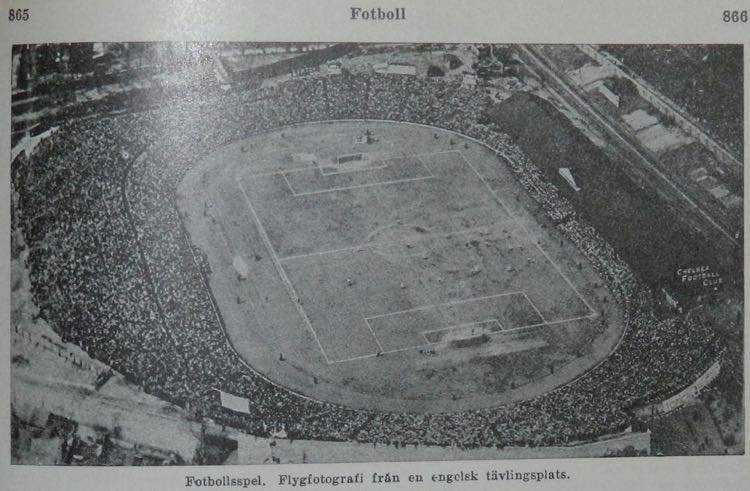
In Chelsea’s early years, Stamford Bridge was often jam-packed, with the ground’s official record attendance coming back in 1935. Officially at least, some 82,905 spectators watched on as the Blues took on Arsenal, with the game ending 5-2 to the Gunners. However, it is highly likely that the stadium’s highest attendance is well over 100,000.
In 1945, following the conclusion of the Second World War, Russian side, Dynamo Moscow, were invited to come and tour the UK, playing a number of exhibition matches. Their first game was against Chelsea at Stamford Bridge, and a combination of the lack of football for the past six years, as well as the excitement of playing a foreign team, led to an enormous crowd of spectators descending on the ground. Over 100,000 fans packed into the stadium, which made it impossible for the club to accurately record attendance, as many of those watching stood on the ground’s dog track, or even on top of the stands!
The Crisis of the 1970s
In the early 1970s, Chelsea’s owners decided to renovate the ground. The idea was to move the entire stadium northwards, in order to remove the old athletics track, which would then allow new stands to be built directly adjacent to the pitch. However, they quickly encountered several serious problems.
The new East Stand was constructed first, and this was incredibly expensive, due to a severe shortage of materials and builders going on strike. This left no room in the budget to renovate the other stands, meaning that the new East Stand was around 20 metres away from the pitch, and the athletics track remained!
This saga also unfortunately coincided with a period of poor form for Chelsea that saw them relegated to the Second Division in 1975, and then again in 1979, causing attendances to decrease and debts to pile up quite dramatically. The Blues were in financial dire straits, with a severe shortage of money for anything at all, and were therefore forced to sell Stamford Bridge’s freehold, separating it from the club itself.
This meant that when Ken Bates bought Chelsea for a measly £1 in 1982, he did not also own the stadium. It then took Bates until the 1990s to buy back the freehold, which had been purchased by Marler Estates. Without Bates’s intervention, the club may have faced bankruptcy, and the future Leeds owner went on to make a pretty good return on his investment, as he was able to sell the club on to Roman Abramovich in 2003 for around £140 million.
Modernisation of the Ground
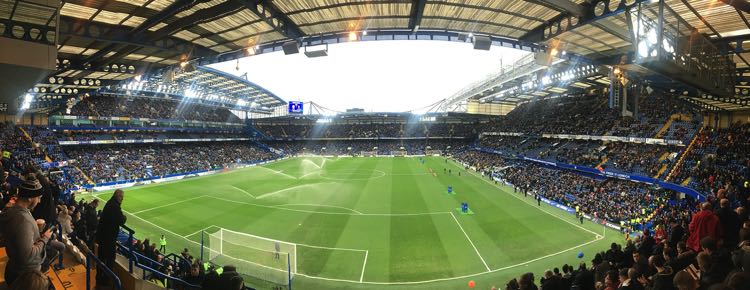
Following the Taylor Report, published in the wake of the Hillsborough disaster, in January 1990, Chelsea, alongside all other First Division sides, were ordered to convert their ground to an all-seater stadium. Permission to do so from the council was acquired in July 1990, with the club planning to build a 34,000-capacity ground, with this construction also involving the removal of the running track.
The track had always kept a distance between supporters and the game’s action, but now, with the ground also boasting newly roofed stands, the fans in Stamford Bridge were able to create an impressive and intimidating cacophony of noise. Furthermore, in order to avoid a future crisis in which the stadium’s freehold was once again purchased by property developers, Chelsea Pitch Owners was set up. CPO is a non-profit organisation that effectively owns the ground underneath Stamford Bridge, as well as the club’s naming rights, and is led by fans. The stadium’s redevelopment was designed by KSS Design Group, who also designed the ground’s hotels, club megastore, offices and residential buildings.
Have Chelsea Tried to Extend Stamford Bridge Since?
In recent times, most of the Premier League’s big boys have either built new stadia or at the very least expanded their existing facilities. Increasing capacity, especially in terms of lucrative hospitality options, gives a club the ability to generate far more revenue and the Blues have lagged behind a little in this regard.
Building a New Bridge
For a club of Chelsea’s stature, the capacity of 41,837 offered by the Bridge, only the ninth largest in the Premier League, seems a little under-sized. Because of this, in 2017, Roman Abramovich decided that he would attempt to build a new 60,000 capacity ground, which would involve demolishing the old ground, and building another, larger, stadium on the same site. However, this proposal came with numerous problems.
Firstly, it would be enormously expensive; it was estimated that around £600 million would need to be allocated to constructing the stadium, and secondly, Chelsea would be unable to play at Stamford Bridge for a minimum of three seasons, with no guarantee of when they would be able to return. In attempting to make this reconstruction viable, the club faced backlash from Chelsea Pitch Owners, who did not approve of the proposal. It didn’t help either, that in 2016, the owners unpopularly attempted to buy back the stadium’s freehold from Chelsea Pitch Owners, which would have then allowed the club to build a new stadium without the CPO’s fan-led involvement. However, due to the enormous cost and difficulty in making this proposal viable, the idea was abandoned.
Trying to Extend the Current Ground
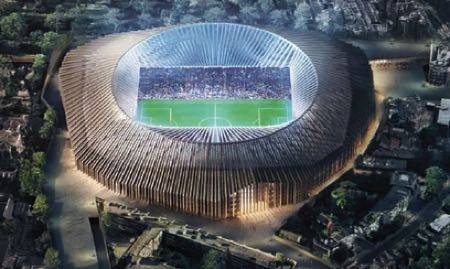
Attention was then turned to the current Stamford Bridge ground, and whether it could be extended to hold more fans, with the owners exploring the possibility of upping its capacity to 55,000. However, this plan would also be financially challenging, as the cost-per-seat of expanding the stadium in this way would be extremely high, and this plan was also quickly abandoned.
With the off-pitch turmoil at Chelsea, including Abramovich first withdrawing a UK visa application in 2018 and then selling the club in the wake of the Russian war against Ukraine, redeveloping Stamford Bridge has been put on the back burner. However, the financial imperatives of increasing capacity mean that the new owners are sure to be exploring options sooner rather than later.

